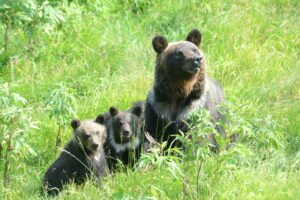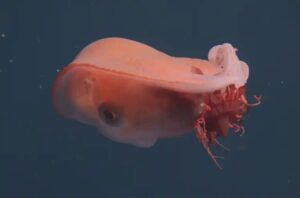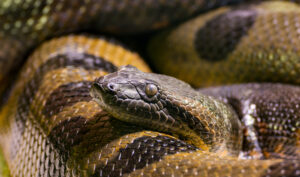Two species of whale follow deep sea trawlers and chow down on fish that escape the nets. Researchers witnessed this behavior frequently in the North Atlantic, off the coast of Newfoundland.
As fishermen haul nets into the boat, the whales eat the fish that fall back into the water. Interestingly, they only do this if the catch is Greenland halibut.
Fussy eaters
The fussy eaters only displayed the behavior with one catch type. When the trawlers bring in redfish or thorny skate the whales are nowhere to be seen. Over 50 days, Usua Oyrabide, the lead author of the new study, observed 129 encounters with sperm whales and 89 with northern bottlenose whales.

Northern bottlenose whales. Photo: Northern Atlantic Marine Mammal Commission
Both species of whales, along with many other cetaceans, feed on the offal and discards from fishing boats. But this is the first time researchers have seen them actively follow trawlers and feed on live fish.
The sperm whales will go further than the bottlenose whales to get an easy meal. They follow for long periods during towing and swim parallel to the ship until the crew raise the nets. In some cases, they did this for over an hour. Researchers spotted several individual sperm whales returning on different days.
Changing whale behavior
The research team believes the study shows that fishing practices are changing whale behavior. Some whales swim hundreds of kilometers away from their original location to follow the potential food source.
“It appears that sperm and northern bottlenose whales have learned to identify the fishing vessels as a source of fish that are easier to catch. Halibut escaping from trawl nets are likely dazed, making them easier to catch and reducing the time whales need for foraging,” Oyarbide said.

Sperm whale (A) and northern bottlenose whale (B) breaching. Northern bottlenose whales close to the boat at the end of hauling (C and D). Photo: Oyarbide et al., 2023
These new interactions between whales and ships are worrying. The fishing industry has a complicated relationship with cetaceans. In the short term, some individual whales greatly benefit from the easy food source. They spend less time foraging and often get a large payout. However, long term it poses several threats. Ship strikes, entanglement in nets, ghost fishing, and cetaceans as bycatch are all likely issues.
Cetaceans are highly intelligent and sociable creatures. As witnessed in this study, they can adapt to take advantage of a new food source. They can also communicate this to others. Toothed whales pass information to individuals within their group and to other groups of the same species. This poses another problem. They may come to rely on this as a permanent food source. This would make them more vulnerable to the risks associated with fishing boat interactions and to any changes in fishing practices in the future.






